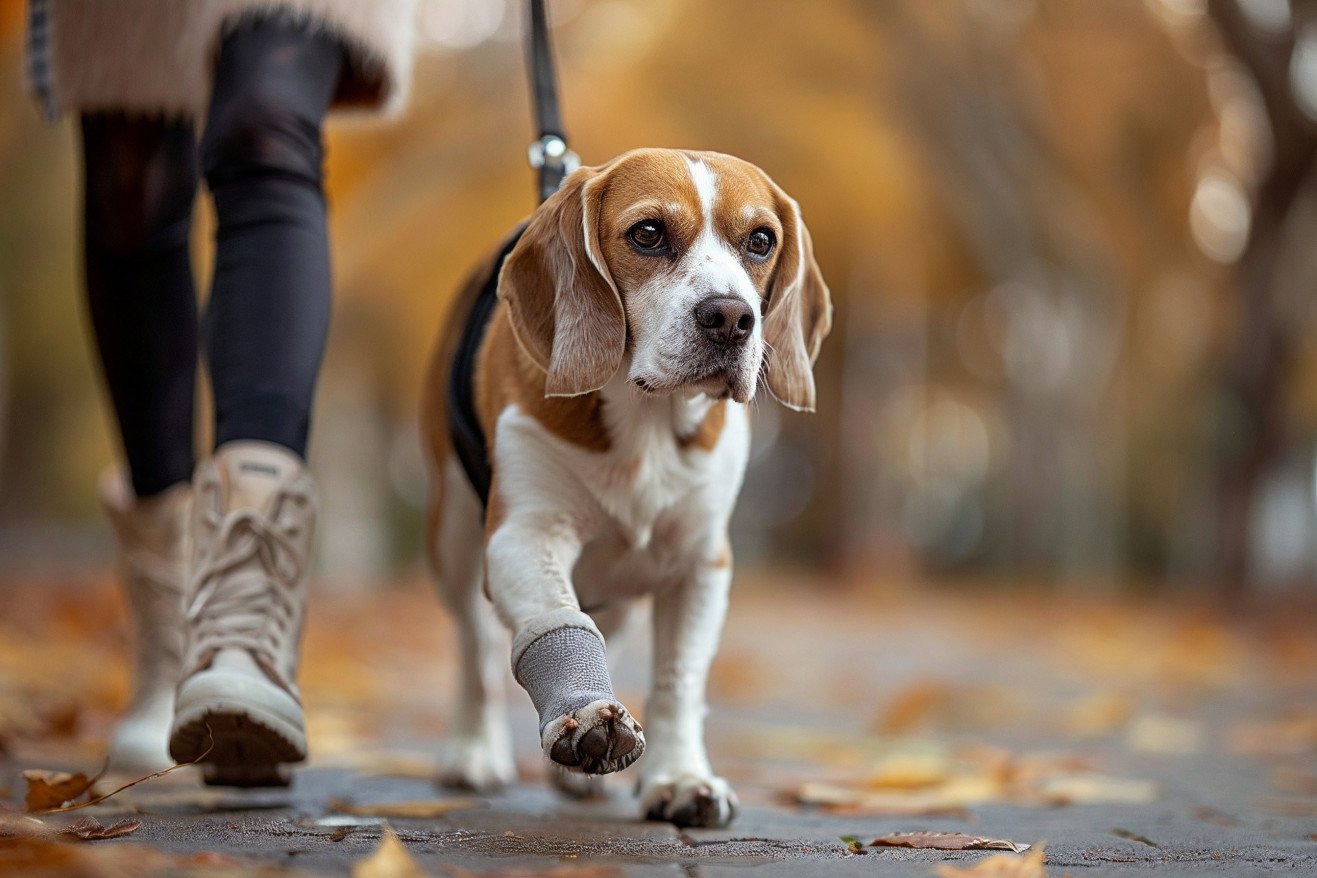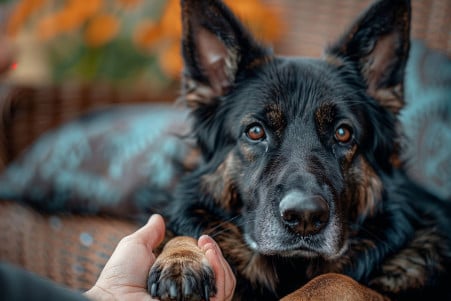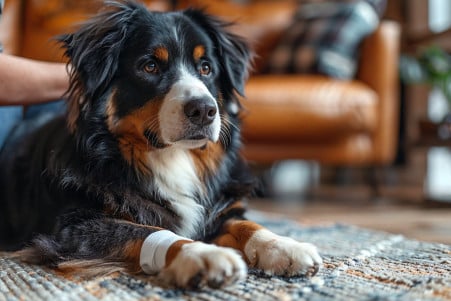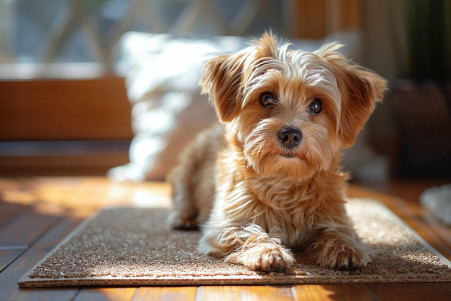Walking Your Dog After a Nail Injury: Safe Practices Post-Cutting the Quick
11 March 2024 • Updated 10 March 2024

Dealing with the aftermath of cutting your dog’s nails too short can be a traumatic experience, but what happens after that? After cutting the quick, make sure you’ve stopped the bleeding and that the area is pain-free before you take your dog for a walk.
If the injury is mild, you can usually take your dog for a light walk within an hour. To avoid reinjury and infection, make sure your dog stays away from rough surfaces.
We will cover insights from veterinary science, animal behavior studies, and pain management techniques to help you make sure your dog is properly cared for after their injury. This will include understanding a dog’s paw anatomy and sensitivity, finding out what the best practices are for immediate care after a quick injury, and learning what the best practices are for safely returning to activities like walking.
Our investigation is designed to give you a well-rounded plan to make sure your dog is comfortable and healing.
Can I walk my dog after cutting the quick?
Anatomy of a Dog’s Paw and the Quick
The paw is a dog’s version of the human hand and foot, and it’s a complex structure built for both endurance and speed. The nails are there to provide traction, and each one has a quick, which is a sensitive area that contains blood vessels and nerves.
Because of this, if the quick is injured, it can be painful and cause bleeding. The quick is visible in light-colored nails, which makes it easier to avoid when trimming. However, the quick is not visible in dark nails, which makes it harder to avoid.
Dogster explains that to avoid injuries, it’s important to check and trim your dog’s nails regularly.
To avoid injuries, it’s also important to learn how to find the quick. One way to avoid the quick is to trim the nails in several small increments, which will allow you to see a small dot in the middle of the nail that indicates you’re getting close to the quick.
The paw’s anatomy, including the digital and metacarpal pads, is responsible for bearing the dog’s weight and regulating body temperature. This means that these pads are essential for a dog’s recovery and rehabilitation after an injury, and it’s important to be gentle with them while they’re healing.
What to Do Right After You Cut the Quick
Take action quickly to reduce pain and avoid additional issues if you accidentally cut the quick during a dog’s nail trim. According to Woof Blankets, the first thing to do is stop the bleeding, which can often be done by using clotting powder directly on the wound.
If you don’t have clotting powder, cornstarch or flour can be used as a temporary solution. That said, if the bleeding is heavy or doesn’t stop after a few minutes, it’s important to get your dog to a vet as soon as possible.
It’s also important to keep an eye on your dog for signs of pain and discomfort. This means looking for changes in behavior like crying or licking the area more than usual, which can be signs of pain. Make sure to keep a clean, protective bandage on the area and keep it clean to protect the damaged nail and prevent infection.
If your dog continues to experience pain or if the bleeding won’t stop, make sure to take them to the vet to have the injury assessed and treated. Proper pain relief will help your dog heal faster and will help them get back to their normal activities like walking sooner.
Understanding Pain and Monitoring Progress
After an injury, it is important to be able to accurately understand your dog’s body language to determine how much pain they are in and when they are ready to start walking again.
As noted in a report from ScienceDirect, dog owners are often able to recognize pain through changes in their dog’s daily habits and body language. This can include a decrease in sociability, a lack of interest in normal activities, and pain-related behaviors like limping or not wanting to walk.
To determine how comfortable your dog is with walking after an injury, you can monitor how willing they are to put weight on the injured leg. You can also start with short, easy walks on soft surfaces and see how your dog responds. If they are walking without any signs of pain or discomfort, you can gradually increase the length and difficulty of the walks.
McRehabilitation also suggests that you slowly work your dog back up to their normal exercise and walking routine, making sure that they are properly warmed up and cooled down to avoid further injuries. Make sure that you are paying attention to how your dog is reacting to their exercise and adjust it as needed.
Making sure that your dog is comfortable and managing their pain well will help them have a better quality of life and be able to walk and exercise without pain.
Pain Management After a Nail Injury
Pain management is important after a nail injury to help your dog heal and get back to walking. According to WebMD, it is important to talk to your vet before starting any pain management plan because dogs can’t tell you when they’re in pain.
Vets often prescribe veterinary-approved NSAIDs like Carprofen and Meloxicam to help with pain and inflammation in dogs. However, these should be used carefully to avoid side effects on the kidneys and liver.
Some natural remedies, like glucosamine supplements, may help with joint health and pain relief, but the research is mixed. In addition, rest is an important part of the healing process.
It is important not to give dogs human pain medications like ibuprofen, which can be toxic. According to VCA Animal Hospitals, your vet may also prescribe other medications, such as gabapentin or tramadol, in addition to NSAIDs, depending on your dog’s situation.
Proper pain management will help ensure your dog’s comfort and well-being and make it easier for them to get back to their normal routine. Always talk to your vet to make sure you are using the best pain management plan for your dog and to make sure you are using safe pain management practices.
How to Walk Your Dog Back to Health: A Post-Injury Plan
When walking your dog back to health after an injury, it’s important to be cautious and take things slow. This may mean using booties or wraps as protective measures to help shield the injured paw. Pawsafe recommends that dog owners walk on soft, level ground to minimize the amount of pressure on the injured paw. In addition to physical protection, booties can also help prevent contamination that could lead to an infection.
It’s important to take a gradual approach, starting with short walks and closely monitoring your dog for signs of pain or discomfort. If you notice that your dog is in pain, Woof Blankets advises that you should postpone the walk. How your dog reacts to the walks will determine how quickly you can increase the length and difficulty of the walks.
If walking isn’t an option, it’s important to remember the value of other forms of exercise and mental stimulation. Keep your dog’s mind active with light play or toys that dispense treats to ensure that you’re meeting their physical and mental needs, even if they can’t move around as much as they’d like. This well-rounded approach to recovery will help ensure that your dog can safely and comfortably return to their regular walking routine.


